Jstor Huntington Early Buddhist Art and the Theory of Aniconism

Aniconism in Miracle at Kapilavastu: King Suddhodana praying as his son the Buddha rises in the air, praised by celestial beings (simply but the Buddha's path, the Chankrama horizontal slab in the air, is visible).[ane]
Since the beginning of the serious study of the history of Buddhist fine art in the 1890s, the earliest stage, lasting until the 1st century CE, has been described as aniconic; the Buddha was only represented through symbols such equally an empty throne, Bodhi tree, a riderless horse with a parasol floating higher up an empty infinite (at Sanchi), Buddha'southward footprints, and the dharma wheel.[ii]
This aniconism is relation to the image of the Buddha could be in conformity with an ancient Buddhist prohibition confronting showing the Buddha himself in human grade, known from the Sarvastivada vinaya (rules of the early Buddhist schoolhouse of the Sarvastivada): ""Since it is not permitted to brand an image of the Buddha's body, I pray that the Buddha volition grant that I tin can brand an paradigm of the attendant Bodhisattva. Is that acceptable?" The Buddha answered: "Yous may make an image of the Bodhisattava"".[3]
Although there is still some argue, the offset anthropomorphic representations of the Buddha himself are frequently considered a result of the Greco-Buddhist interaction, in particular in Gandhara, a theory outset fully expounded by Alfred A. Foucher, but criticised from the start by Ananda Coomaraswamy. Foucher besides deemed for the origins of the aniconic symbols themselves in small souvenirs carried away from the master pilgrimage sites and and then condign recognised and popularized equally symbolic of the events associated with the site. Other explanations were that information technology was inappropriate to stand for ane who had attained nirvana.[4]
However, in 1990, the notion of aniconism in Buddhism was challenged past Susan Huntington, initiating a vigorous fence amidst specialists that yet continues.[5] She sees many early scenes claimed to be aniconic as in fact not depicting scenes from the life of the Buddha, but worship of cetiya (relics) or re-enactments by devotees at the places where these scenes occurred. Thus the paradigm of the empty throne shows an actual relic-throne at Bodh Gaya or elsewhere. She points out that there is only one indirect reference for a specific aniconic doctrine in Buddhism to be constitute, and that pertaining to only i sect.[6]
As for the archeological show, information technology shows some anthropomorphic sculptures of the Buddha actually existing during the supposedly aniconic period, which ended during the 1st century CE. Huntington also rejects the association of "aniconic" and "iconic" art with an emerging division between Theravada and Mahayana Buddhism. Huntington's views have been challenged by Vidya Dehejia and others.[7] Although some before examples accept been found in recent years, it is mutual ground that the large complimentary-standing iconic images of the Buddha so prominent in later on Buddhist art are not found in the primeval period; discussion is focused on smaller figures in relief panels, conventionally considered to represent scenes from the life of the Buddha, and at present re-interpreted past Huntington and her supporters.
-

Devotions to the empty throne of the Buddha, Kanaganahalli, 1st-3rd century CE
Aniconism and anthropomorphism [edit]
Depending on the schools of fine art or the catamenia, the Buddha can only appear through his symbols, or in anthropomorphological class, in similar works of fine art.[10] [11]
| Sanchi and the Greco-Buddhist art of Gandhara | |||||
| Maya'due south dream | The Great Departure | Mara's assault | Enlightenment | The Buddha Preaching | |
| Sanchi (1st c. BCE/CE) |  Maya's dream of a white elephant. | 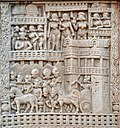 The Buddha, under the umbrella on the chariot, is not illustrated. | 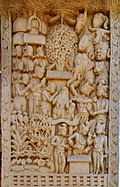 The Buddha is symbolized by an empty throne. | 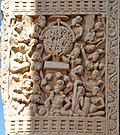 The Buddha is symbolized by an empty throne. | 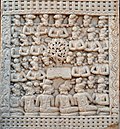 The Buddha is symbolized by an empty throne. |
| Greco-Buddhist art of Gandhara (1st c.CE-4th c.CE) |  Very similar analogy from Gandhara. |  The Buddha in person leaves the metropolis. |  The Buddha is illustrated centrally. | 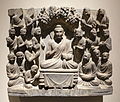 The Buddha is illustrated centrally. |  The Buddha is illustrated centrally. |
Afterward periods [edit]
In afterward periods both the major schools of Buddhism have fabricated swell use of representational art, though Theravada temples and other sites typically concentrate on a unmarried big sculpture of the Buddha, whereas Mahayana temples have larger numbers of images of a greater diversity of figures with varying degrees of spiritual significance. However some schools, such every bit Zen Buddhism in Nihon, take also shown a general tendency towards aniconism, though without specific prohibition of figurative images.
Encounter also [edit]
- Gautama Buddha
- Dhamma
- Sangha
- Iii Refuges
- Five Precepts
- Pāli Canon
- Cetiya
- Iconoclasm
Notes [edit]
- ^ Marshall p.58 Third Panel
- ^ Huntington, opening pages
- ^ Rhi, Ju-Hyung (1994). "From Bodhisattva to Buddha: The Showtime of Iconic Representation in Buddhist Art". Artibus Asiae. 54 (3/4): 220–221. JSTOR 3250056.
- ^ Krishan, 9
- ^ Run across note 7 here for an update on the controversy equally of 2007, and here for another from 2001.
- ^ (Huntington 1990) [ane] and hither
- ^ (Huntington 1990) [2] and here
- ^ "The bas-relief at Pauni or Bharhut in India, which dates back to well-nigh the second century B.C., represents a vacant throne protected by a naga with many heads. It besides bears an inscription of the Naga Mucalinda (Fig. 3)" SPAFA Assimilate: Journal Of SEAMEO Projection in Archaeology and Fine Arts (SPAFA). SPAFA Co-ordinating Unit. 1987. p. 4.
- ^ Krishan, pp. 1 and 5, fig 4a caption
- ^ Krishan, Yuvraj; Tadikonda, Kalpana K. (1996). The Buddha Prototype: Its Origin and Evolution. Bharatiya Vidya Bhavan. ISBN978-81-215-0565-9.
- ^ Dehejia, Vidya (1991). "Aniconism and the Multivalence of Emblems". Ars Orientalis. 21: 45–66. ISSN 0571-1371. JSTOR 4629413.
References [edit]
- S. L. Huntington, Early Buddhist art and the theory of aniconism, Art Journal, 49:four (1990): 401-viii. ]
- Krishan, Yuvraj, The Buddha image: its origin and evolution, 1996, Bharatiya Vidya Bhavan, ISBN 81-215-0565-8, ISBN 978-81-215-0565-ix. - a clear and well-illustrated business relationship of the traditional view
- Rob Linrothe, Inquiries into the Origin of the Buddha Epitome: A Review. In: East and West, 43 (1993): 241-256.
Source: https://en.wikipedia.org/wiki/Aniconism_in_Buddhism